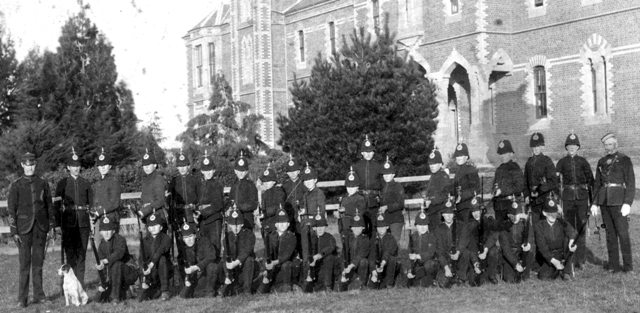CADET CORPS See Also
ShootingEstablished under the auspices of the National Cadet Movement, the College Cadet Corps was started in 1885 with 51 enrolments although drilling had been a College activity since the 1860s. They were armed with Martini-Henri rifles and carbines and resplendently uniformed in a blue serge tunic, trousers with red piping and a blue cheese-cutter cap topped by a red pom pom. This smartly equipped corps was reviewed on 4 September of that year to considerable praise from Lieutenant-Colonels Brownrigg and Rashleigh. Although no images of this early 1885 cadet corps are known to have survived, a photo from late 1886 depicts the corps in their then new uniforms of dark green tunic and trousers with a conical helmet with a spike on top. This uniform appears to have persisted until the introduction of the more serviceable khaki in 1889. In 1892 a dark blue Glengarry cap was introduced for the winter months.

College Cadet Corps, 1886.
In the early 1890s Lieutenant Norman Morrison, son of founding Principal, George Morrison was particularly enthusiastic to revitalise the College Cadets. It became an almost military mission to raise the standards of the Corps and capture the most significant awards on offer from the Victorian Rifle Association and in particular the Queens Colours. After he became School Principal, the Cadets remained his pre-eminent interest. Although drilling was one of the main activities it was shooting that was the pivotal activity, and in the years up to World War I the College excelled. In particular, 1905 was a year of resounding success and the College was the dominant school filling the first four positions in the senior individual shooting competition; and claiming the Cumming Cup; the Field Firing Competition; and both the junior and senior Sargood Shields for team shooting. Tragically, not long after, in 1908, Norman Morrison was himself killed in a shooting accident. In a further irony the Schools' shooting prize was named in 1910 after Norman Morrison but Geelong College was never afterwards able to claim victory.
Standards among the Melbourne schools gradually rose and Geelong College was not able to continue its dominance of the schools competition, being narrowly defeated on several occasions after 1905. With the New Defence Act of 1910 and the introduction in 1911 of Compulsory Universal Training and its focus on a fixed program of parades, drill and physical exercise the role of shooting diminished. The onset of World War 1 was to wash these old ways away on a tide of sacrifice.
There was little enthusiasm for cadets in the period after World War I and it was not until 1930 that an 'Officers' Training Corps was established and several years later made compulsory at the School. Interrupted again by war, resurgence of the Cadets was slow until, in 1948, re-organisation of the corps occurred, with the formation of two infantry companies, a pipe band and a specialist platoon of three sections—signals, MMG and mortar. In 1949 the old khaki uniform was superseded for the smarter look of the tartan kilt of the Gordon Highlanders, and on 3 April 1949 the Corps paraded on Mackie Oval for the first time in their new uniforms. The College once again demonstrated its prowess winning the Victorian State Competition for drilling from 1949 to 1955.

College Cadet Corps Parade on the Main Oval, 1957.
There were many skilled soldiers and teachers associated with the Cadets over the years. Drum Major Rashleigh served for almost 30 years. Between the wars Lieutenant C C Shinkfield and Captain R Lamble MC commanded, and in 1948 Lieutenant Colonel H L E Dunkley returned from active service to supervise the reformation of the Corps. Others including Captain J H Campbell and Dr Buntine were instrumental in the success of the Corps.
The year 1975 proved to be a turbulent and significant year for the Geelong College Cadet Corps for not only was this the first year that girls joined the corps, it was also to be the last year of government funding for the Cadets. The demise of the Cadets was barely acknowledged in
Pegasus but with the withdrawal of funding, so ended a proud discipline at the Geelong College extending back to 1885 and the principalship of George Morrison. Today, shooting remains an optional activity at the College and the Clay Target Shooting Team continues to uphold a long and noble tradition.

Mortar and MG Group, 1953.
Cadet Corps Commanding Officers:
1884 Marden, Lieut
1898-1909 Morrison, C.N.
?-1915 Lamble, R.
1916-1917 MacGregor, C.
1918-1919 Hill, V. R.
1920-1924 Strover, C. H.
1931 Shinkfield, C. C.
1932-1947 Lamble, R.
1948- Dunkley, H. L. E.